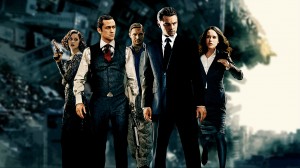Inception: A Kabbalistic Take on the Film (Part 2)
By Asher Crispe: December 19, 2012: Category Inspirations, Living with the Times
 The life of a ‘world traveler’ has quite a different meaning in Kabbalah. To begin with, we don’t just travel within a world, we also have opportunities to travel between worlds. To facilitate this, the only ticket we require lies in our conscious mind. As the Ba’al Shem Tov famously remarked, ‘a person is wherever his [or her] thoughts are.’ Thus, I travel–in my mind. This should not be construed as zoning or spacing out. Much of the real power in the mind entails unlocking hidden dimensions of reality that operate all the time, all around us, hitherto unnoticed. Our itinerary takes us through four ‘ports of call’ which stand for our four mystical worlds (Emanation, Creation, Formation and Action). We float away from one and wash ashore on another. As we shall soon discover, these worlds can be accessed through alternating states of wakefulness and sleep.
The life of a ‘world traveler’ has quite a different meaning in Kabbalah. To begin with, we don’t just travel within a world, we also have opportunities to travel between worlds. To facilitate this, the only ticket we require lies in our conscious mind. As the Ba’al Shem Tov famously remarked, ‘a person is wherever his [or her] thoughts are.’ Thus, I travel–in my mind. This should not be construed as zoning or spacing out. Much of the real power in the mind entails unlocking hidden dimensions of reality that operate all the time, all around us, hitherto unnoticed. Our itinerary takes us through four ‘ports of call’ which stand for our four mystical worlds (Emanation, Creation, Formation and Action). We float away from one and wash ashore on another. As we shall soon discover, these worlds can be accessed through alternating states of wakefulness and sleep.
The idea in the film Inception is to move from a fully conscious awaking reality to the dream world by falling asleep (either individually or collectively). This process is then repeated within the dream, which is to say that the first ‘sleep-dream’ state now becomes a new level of ‘consciousness’ even though it is the ‘unconscious‘ relative to the waking state that preceded it. The same goes for subsequent iterations of the process. Each new sleep state takes the subject out of play in the dream world above, and starts up one’s participation in the new, lower dream world. Thus, the dream within the dream supplants what was once just the dream and now occupies center stage within our conscious mind. So too, in the dream within the dream within the dream, we endure three degrees of separation from our original consciousness. Welcome to the mental jungle.
Joining this structuring of reality in the movie to our schema of worlds in Kabbalah can happen in two different ways. Our modeling can draw the parallels from the top-down or from the bottom up. From the standpoint of the world of Emanation, the only true consciousness is that of the Oneness of the Creator. In the normative locution of Chassidic thought: Elokut b’pashitut (Divinity is simple and apparent) while olamot b’hitchadshut (worlds are a suspicious novelty). In this configuration of reality, creation is like ‘nothing’ while the Creator is ‘everything.’ Transposed into less theological language, the unity of all Being and Reality dominates our consciousness to the exclusion of an independent reality of worlds that would seem to break up this original unity. The existence of anything ‘other,’ anything ‘separate,’ is cast in doubt. As a result, I am only really awake and fully conscious when I apprehend the metaphysical truth of a single seamless Reality.
Sleep then becomes the first schism within this pristine level of consciousness whose bifurcation leaves the experience of an original unity temporarily out of reach, having been forgotten. The dream experience refocuses my attention on something entirely derivative of Reality but not real in and of itself in the way it is presented to me. Withdrawn and distracted from the my ‘waking’ state, I become hypnotized by the virtual reality replacement that I ‘dreamt’ up. This then could be likened to the descend down into the world of Creation which introduces a degree of dual-consciousness into my experience. ‘Entertained’ by the ‘fracturing’ within my mind (that compels me to leave part of myself behind just as a sleeper’s body stays behind where it lay) I am left with a damaged experience of myself, my world and my relationship with my Creator.
The film beautifully captures this experience through the expository exchange between characters which reflects upon the ‘throwness’ into the dream world. We don’t recall the ‘inception’ of the dream. Our dream narrative always begins in the middle and I can’t recall how I got there. So too, with the exilic condition–we have lost touch with the root causes that triggered it and we eventually adjust to the most horrendous conditions within our world and accept them as normal. When the dream becomes the new normal, then we can be said to have resettled within this lower world for as long as we are prevented from either waking back up (arising to the world of Emanation) or dropping off to sleep within the world of Creation and descending down to the world of Formation. Moreover, our general resistance to wanting to wake up has to do with the self-medicating and auto-anesthetizing quality of the dream itself.
As in the film, the same scenario repeats itself as we fall further asleep in the world of Formation and fall down to the world of Action. Now I am asleep to being asleep to being asleep, or I am unconscious of being unconscious of being unconscious. It is easy to get lost in such a thicket of confusion. The basic system of Four Worlds with their respective ‘contractions’ of Divinity (or really contractions [tzimtzumim] of our awareness of Divinity) would thus be:
Emanation = Fully Conscious/Awake
Creation = Dream Level One
Formation = Dream Level Two (Dream within a Dream)
Action = Dream Level Three (Dream within a Dream within a Dream)
Creation, Formation and Action constitute what are called the set of olamot tachtonim or ‘lower worlds.’ Each one represents a distancing or layer of exile from the world of Emanation. The redemption of our ‘damaged’ experience would be when the three lower worlds can ascend and unify with the world of Emanation. This restoration effectively gives us a wake up call in all of the worlds and enables us to become fully conscious of the dream on all levels. No longer fooled by the dream, we can connect our dream experience back to that which is real and also see how the Divine was hidden in the lower worlds and their respective dream all along.
Yet, this only explains the three levels in that Cobb and his band of accomplices planned to drop into. What about the unintended fourth level–where they fall yet again into another dream layer that they have to build entirely out of their own imagination called ‘limbo?’ Have we not exhausted our system of worlds? Once the elevator opens on the ground floor in the world of Action there would appear to be nowhere left to go but up? In response to this dilemma, the 19th century Chassidic master, Rabbi Yitzchak Isaac of Homil, maintained that there is an ‘unworldly’ realm (having fallen below the domain of the Four Worlds proper) that is below the world of Action. This purely virtual state he refers to as tachat ha’mitziut where tachat means ‘under’ or ‘in place of’ and mitziut means ‘reality.’ When we are completely deluded by the musings of our imagination, and totally cut off from any real world, we are in this ‘underworld’ substitute for reality. In the classic terminology of Kabbalah, this underworld is comprised of klippot or ‘shells.‘ Basically, swallowed in our subjective imagination we only sense something that approximates a world but in essence is only a collage of hollow images or husks.
The circulation of these false images and impressions can have us occupied for a lifetime but they don’t really lead anywhere. On the contrary, they continually stymie our attempts to break free from them. Only by totally nullifying these ego-projections (as portrayed in the movie as ‘dying’ in limbo) can a person escape back to reality. Our ‘notes from the underground’ have to be placed on the mirror that we regularly gaze into in order to trigger the faintest of memories in our heart of hearts that tells us that this cannot be real and that one day I (we) are going to wake up.
 As in the film, once our higher spiritual awareness wanes and we slide into the un-realities conjured in our unconscious, we becomes susceptible to having our deepest secrets and most valuable assets (which is our relationship with the Divine and the full powers of our soul) stolen from us. Just as the character of Robert Fischer inherits an ‘energy conglomerate’ from his father, we too inherit a superabundance of wealth in the form of our combined resources and partnership with the Creator. Teamed together and unified, there is no stopping us. But breaking up the ‘Parent company’ (our Divine source) opens room for the competition. Our ‘adversaries’ can then get the better of us in life. The trick, therefore, entails keeping it all together even in the midst of the deepest sleep of exile and knowing that our ‘Father’ above would never want our spiritual ‘energy conglomerate’ to be broken up.
As in the film, once our higher spiritual awareness wanes and we slide into the un-realities conjured in our unconscious, we becomes susceptible to having our deepest secrets and most valuable assets (which is our relationship with the Divine and the full powers of our soul) stolen from us. Just as the character of Robert Fischer inherits an ‘energy conglomerate’ from his father, we too inherit a superabundance of wealth in the form of our combined resources and partnership with the Creator. Teamed together and unified, there is no stopping us. But breaking up the ‘Parent company’ (our Divine source) opens room for the competition. Our ‘adversaries’ can then get the better of us in life. The trick, therefore, entails keeping it all together even in the midst of the deepest sleep of exile and knowing that our ‘Father’ above would never want our spiritual ‘energy conglomerate’ to be broken up.
We will continue in Part Three with the bottom-up version of our many dream worlds.
http://www.interinclusion.org/inspirations/inception-a-kabbalistic-take-on-the-film-part-3/
Inception: A Kabbalistic Take on the Film (Part 2),






















;)
;)
;)
;)
;)
;)
;)
;)
;)
;)

Great blog!
“There is a visionary mirror [Shekhinah] reflecting supernal colors [the upper sefirot], envisioned in that visionary mirror; there is vision within vision, and vision within vision, one above the other, all poised on specific rungs, presiding, called night vision [Daniel 2:19]. Through them spread all dreams of the world, these resembling those above” (Zohar 1:196a).